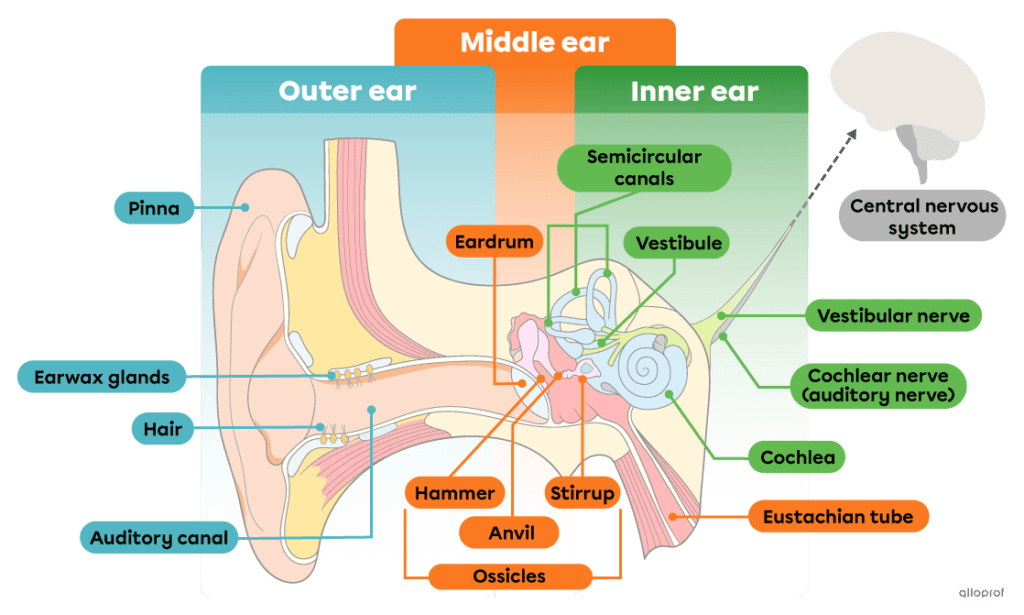Hearing and Balance. What is it?
The Auditory and Vestibular Pathway
Your EARS and their Anatomy– Your ears are organs placed on each side of your head responsible for hearing and balance1,2. By understanding how they work correctly, it’s possible to appreciate the disease processes that cause this system to go wrong or be interrupted.
The ear is an intricate organ with many different parts. These parts coordinate to receive sound waves and convert them into electrical impulses that the brain can process. This is what allows us to hear sounds.1
Your ears consist of three parts1,2:

The Outer Ear1,2 – this is the part of the ear that you visibly see. It is made up of the auricle or pinna, which consists of ridged cartilage and skin; the auditory/ear canal, within which are hair and glands that secrete ear wax. Ear wax shields the auditory canal from dirt, bacteria, insects, and other harmful substances3. It prevents dryness and cracking in the ear canal.
The auditory canal leads to the tympanic membrane or ear drum. The outer ear directs sound to the middle ear.
The Middle Ear1,2 – this consists of the eardrum, three tiny bones called ossicles{malleus(hammer), incus(anvil) and stapes(stirrup)} and the Eustachian tube.
The middle ear transfers sound vibrations from your eardrum to your inner ear. Your Eustachian tubes help to regulate the air pressure in your ears.
The Inner Ear1,2 – sometimes called the labyrinth, because of it’s complex shape, houses the Semicircular canals, the Vestibule, the cochlear and is connected to the brain and brainstem via the Vestibulocochlear nerve the VIII (8th) Cranial nerve4. The cochlea transforms the sound waves into nerve impulses that the central nervous system (the brain and spinal cord) can interpret. The semicircular canals are responsible for balance.
Hearing
When a sound wave is formed, the air starts to vibrate. This vibration travels to the pinna of the ear, which sends the sound into the auditory canal. This is how sound passes from the outer to the middle ear.
The ear drum then vibrates, and this vibration passes onto the 3 tiny bones or ossicles in the middle ear in succession, the malleus, incus and stapes. The ossicles amplify and send these sound waves to your inner ear.
The cochlea is a hollow organ shaped like a snail shell. This organ is filled with fluid and its inner wall is lined with ciliated cells.
The little hair cells called stereocilia convert the vibrations into electrical energy and forward it via the nerve fibres of the cochlear branch of the vestibulocochlear nerve2,3 to your brain. Your brain interprets this as sound.
The eyes and ears keep the body in balance. The vestibule, semicircular canals and the vestibular branch of the vestibulocochlear nerve in the inner ear maintain balance.
The semicircular canals are three channels that run along three axes: up and down, left and right, and forward and backward. This arrangement enables the body to orient in three directions. The fluids inside the semicircular canals and vestibule vibrate as the body moves. As a result, the cilia of the ciliated cells that comprise these organs vibrate, delivering a nerve impulse along the vestibular nerve. To maintain equilibrium, the central nervous system analyzes this information, as well as information from the eyes and the rest of the body, sending signals to your muscles to keep you balanced1,2.
Sound waves vibrate through the ear, converting to electrical signals in the cochlea, sent to the brain. Balance is maintained by the inner ear’s semicircular canals and the vestibular nerve.
Long Covid The Answers
Credible Source of Information:
REFERENCES
- EAR – by Cleveland Clinic – great overview of the anatomy of the ear and common disorders of the ear and balance.
- Alloprof – Ears, Hearing and Balance – school learning website, giving a simple but graphic understanding of the ear and its functions.
- Verywell Health Earwax: Why it Builds up and How to Remove It.
- Verywell Health Cranial Anatomy – good explanation and diagram of the 12 cranial nerves.
- Hearing and Balance Video – YouTube